Abstract
The purpose of this study is to investigate the feasibility of replacing the fly ash in synchronous grouting material by reusing the shield mud produced in the clay stratum during the shield construction of Wuhan Rail Transit Line 11. The test utilizes the shield mud from the clay stratum to replace the fly ash material in synchronous grouting at percentages of 20%, 40%, 60%, 80%, and 100%, and research and analyses are conducted on the fluidity, stability, strength, and resistance to water dispersion of the slurry after the replacement; at the same time, improvements in the undesirable phenomenon produced by the synchronous grouting slurry are also examined after the replacement. The results show that, when the fly ash is replaced by shield mud at 80%, the mortar still has good stability and strength performance, but, at the same time, the initial value of consistency and the phenomenon of flow time loss is too large. Through the adjustment of the water–binder ratio and the addition of an appropriate amount of a polycarboxylate superplasticizer agent, the adverse phenomenon of the slurry is effectively improved, and the compressive strength and ease of the slurry are also improved. At the same time, when adding an appropriate amount of hydroxyethyl methyl cellulose (HEMC), the slurry has good water dispersion resistance, but, with the gradual increase in HEMC, the fluidity of the slurry deteriorates and the compressive strength decreases. The test proves that the shield mud in the clay stratum can be used to replace most of the fly ash in an appropriate proportion, which not only solves the problem of the shield mud being difficult to work with, but also provides more valuable insights for tunneling projects.
1. Introduction
In urban underground rail transit projects, the shield method is a very critical part of the construction process. It is efficient and safe, and its engineering characteristics have a low impact on the surrounding environment, so this method has been widely used [1]. During the shield method process, when the shield tail piece is assembled, the tube pieces need to be poured between the soil body and the tube pieces of the synchronized grout in a timely manner to ensure the stability of the surrounding soil body, control the subsidence of the ground, and increase the waterproof function. However, in the case of the use of a tectonic shield, tectonic residue soil is a type of disturbed and chemically contaminated engineering waste soil which will generally be transported to the construction site of the designated mud pool and then finally transported through the mud trucks to the mud treatment plant. The treatment of the mud during this period of time will result in high project costs and risk leakage and spillage in the process of transportation, causing various types of pollution in urban roads, so developing a harmless treatment for shield mud has been the focus of environmental research in recent years [2,3,4]. This study focuses on the concept of “taking soil and using soil” [5,6] to explore the use of shield mud to replace the synchronous grouting in fly ash material, which is not only in line with the concept of sustainable development in today’s world, but can also help greatly reduce the cost of engineering projects.
In recent years, domestic and foreign scholars have conducted research on the reuse of shield tunneling mud, including its improvement, solidification, and reuse, as well as its application in various ceramic granules and non-fired bricks. Jiang et al. [7] elaborated on the various components of synchronized grouting slurry, such as volcanic ash materials, filled fine aggregates, and chemical additives, and provided new perspectives on the diffusion mechanism of the slurry as well as the development of grouting technology. He et al. [8] and Zhou et al. [9] elucidated the composition and research of grouting materials for shield tunnels, summarizing the main factors influencing the performance of synchronous grout slurries and employing various chemical additives and curing agents to achieve optimal results. Zhang et al. [10] conducted experimental research based on subway engineering using nonlinear regression analysis models and three-dimensional response surfaces to study the performance response values of different material ratios in synchronous grouting. Zhang et al. [11] studied the optimization of mud grouting ratios based on the X-ray diffraction technique and laboratory tests based on SPSS multiple regression analysis and the Matlab multi-objective planning tool. Cong et al. [12] and Wu et al. [13] studied the feasibility of using shield dregs as slurry materials for simultaneous grouting and investigated the (w/b) ratio, (b/s) ratio, (sw/w) ratio, and (f/c) ratio of the slurry. The experiment was carried out, the optimization was carried out by a single-factor experiment and RSM analysis method, and finally, the optimal scheme was determined. Ye et al. [14] focused on improving the shield tunneling spoil from homogeneous formations of muddy sandstone and their composition in over-soft and under-hard strata. Ying et al. [15] investigated the feasibility of using excavated soil generated from shield construction in clay strata as a synchronous grouting material and studied the high-performance synchronous grouting material by adopting epoxy resin modification. Ni et al. [16] created an innovative synchronized grouting material using GGBS polymer to perform the complete replacement of cement with shield mud. Liu et al. [17] and Xi et al. [18] used shield mud soil to prepare no-burn mud soil bricks by alkali excitation technology and used various no-burn soil brick test ratios with different metakaolin dosages and different alkali equivalents to find the ideal no-burn mud soil bricks that met the standard requirements. Xu et al. [19] conducted research on the application of shield tunneling spoils from silty formations in synchronous grouting. Adjustments to the grout mix proportions were made based on the performance of the spoils as aggregates in grouting materials to ensure that all performance indicators met the requirements. Lin et al. [20] analyzed the performance of synchronous grouting materials prepared from shield mud sand with different properties and studied the effects of shield mud sand with different particle compositions and plasticity indices on the working performance, mechanical properties, and water dispersion resistance of synchronous grouting materials. Wang et al. [21] developed a new type of synchronous grouting slurry by substituting commercial sand through the study of reusing a large amount of rock mud produced by shield construction in the operation of weathered rock formations. Liu et al. [22] relied on the slurry shield tunneling projects in Nanjing to study the feasibility of reusing abandoned sandy soil generated from slurry shield tunneling in fine sand and rock strata on riverbeds through synchronous grouting. Dai et al. [23] discussed the feasibility of using abandoned mud instead of bentonite raw materials and optimized the slurry ratio through experimental design and goal planning models. Ruan et al. [24] and Zhu et al. [25] improved the water dispersion resistance of cement-based synchronous grouting slurry while ensuring the original performance of synchronous grouting materials, achieving excellent work performance and low cost.
In summary, most of the current research has only been conducted on the shield mud produced by the fine powdered sand stratum or silt stratum. There is a lack of this type of program for the shield mud utilization rate, which is low. Some researchers have used shield mud to completely replace river sand, which warrants debate. At the same time, the use of shield mud as a synchronous grouting material in the research of slurry resistance to water dispersion is relatively scarce. This study uses the clay stratum of the Wuhan No. 11 line project shield mud to replace the fly ash in the synchronous grouting raw material in a single percentage, allowing for quality replacement, with the aim of improving the performance defects in the slurry through the adjustment of the water–binder ratio, as well as through the addition of an appropriate amount of a cement mortar improver to explore the feasibility of using shield mud to replace the synchronous grouting in fly ash material; furthermore, an additional aim is to explore the possibility of grouting in the water-rich layer in order to expand the research on the anti-water dispersion property of the slurry. Moreover, in order to meet the possibility of grouting in the water-rich layer, expand the study on the slurry water dispersion resistance, and finally put forward a set of optimal proportioning schemes, this unique replacement test program on shield residue replacement opted for a gradual increase in content of replacement material to allow for a more intuitive and clear observation of the test state of the slurry. This can be useful for the analysis of the performance of the slurry in the test process, and making the test program better reflect the conditions of the construction site is of significance to the aim of replicating the procedure in the real site, which could offer great economic value and environmental protection.
2. Materials and Methods
2.1. Materials
The shield-tunneling spoil used in this study was obtained from Section 5 of Phase II of the eastern segment of Wuhan Metro Line 11, with the specific extraction point shown in Figure 1. The extracted soil was clay with a light yellow color, having a maximum dry density of 1.812 g/cm3, a liquid limit of 43.3, a plastic limit of 24.2, and a plasticity index of 19.1. The particle size curve distribution diagram of the shield mud was measured by the particle size distribution measuring instrument, as shown in Figure 2.
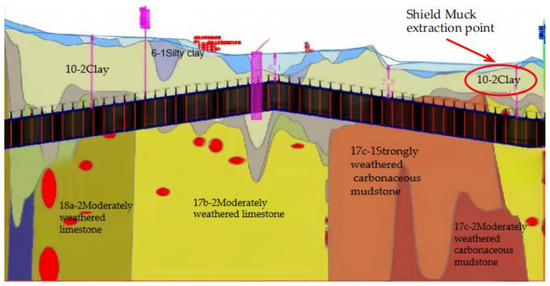
Figure 1.
Longitudinal section diagram of the excavation point for shield tunneling spoil.
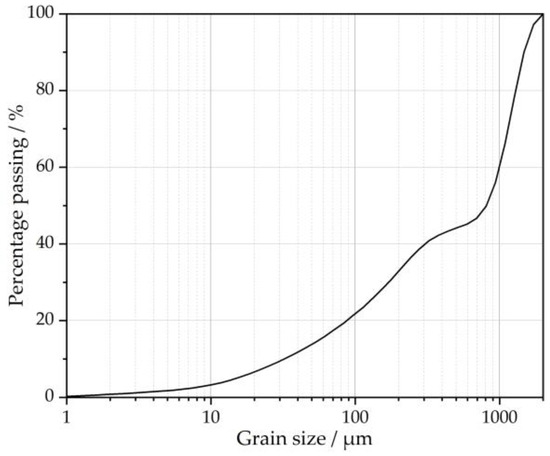
Figure 2.
The particle size curve distribution diagram of shield mud.
The synchronous grouting material used in this study is a single liquid cement slurry, composed mainly of cement, fly ash, bentonite, and water. The fly ash used is a secondary silica–aluminum type of fly ash produced by Henan Province BORUN Refractories Co. The bentonite used is sodium-based bentonite produced by Jiangxi Province Ziyu Building Materials Co. The cement used is P.O42.5 Portland cement produced by Shandong Province Jiu qi Building Materials Co. River sand serves as a fine aggregate, sieved to a fineness of 2 mm. The chemical composition of the above materials was obtained from the product testing report provided by each company, and the specific chemical composition content is shown in Table 1. Cement mortar admixtures included a polycarboxylate superplasticizer produced by Shanxi Province Feike Materials and hydroxyethyl methyl cellulose produced by Henan Province Food Co.

Table 1.
Chemical composition of fly ash, cement, and bentonite (%).
2.2. Test Scheme
The mix ratio for this experiment refers to the grouting mix ratio of the Ding ma section of Wuhan Metro Line 11, with a water-to-binder ratio of 0.52, sand-to-binder ratio of 0.96, bentonite accounting for 15% of the binder materials, and cement accounting for 38% of the binder materials. In order to explore the factors affecting the performance of the mortar by replacing the fly ash content in synchronous grouting with shield mud of clay stratum, a single percentage mass replacement of fly ash in synchronous grouting was carried out with shield residue. The detailed test scheme is shown in Table 2.

Table 2.
Proportioning scheme of synchronized grouting materials for shield soil replacement.
2.3. Performance Requirements for Synchronized Grouting Materials
To ensure that the slurry for synchronous grouting meets construction requirements, the experiment is based on “Technical Regulations for Application of Materials for Synchronous Grouting in Shield Tunneling” [26] T/CECS563-2018. The basic performance requirements for synchronous grouting are divided into three parts: flowability, stability, and strength. These performance indicators for synchronous grouting are adjusted based on construction site specifications from the eastern phase II project of Wuhan Metro Line 11, incorporating shield tunneling mud sampling. The performance criteria for synchronous grouting are shown in Table 3.

Table 3.
Slurry performance requirements.
2.4. Test Method
The indicators of the prepared synchronized grouting slurry are tested, and the test specifications are as follows:
According to Figure 3a, the consistency test was conducted by using a mortar consistency meter with reference to specification [27] JGJ/T70-2009 “Standard of Test Methods for Basic Properties of Building Mortar”. The slurry was poured into the container in two stages and fully pounded, and at the same time, the container was knocked to ensure that the slurry was dense. Each group of specimens was measured once 0 h, 3 h, 6 h, and 9 h after the completion of the sample making, and the result of the test is expressed by the consistency value in cm. According to Figure 3b, slump test specification with reference to GB/T2419-2005 “Measurement Method of Cementitious Sand Fluidity”, the cement mortar fluidity tester was used to carry out the test. The test mold was placed in the center of the jumping table, and the specimen was poured into the test mold in two layers and pounded well. The jumping table was set to jump 25 times at a frequency of once per second. After the table jumping, we used a ruler to measure the diameter length of the spreading slurry at each vertical end and took the average value as the result of each group of specimens in the sample making after 0 h, 3 h, 6 h, and 9 h.
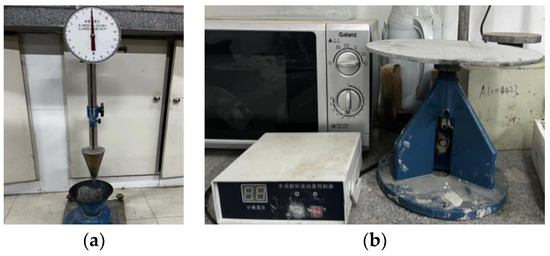
Figure 3.
Slurry fluidity test. (a) Consistency test; (b) slump test.
According to Figure 4a, the bleeding test followed the specifications of [28] JC/T 2153-2012 “Test Method for Cement Bleeding”, using a 1000 mL graduated cylinder. First, the mass of the cylinder was measured; then, the freshly prepared slurry was poured into the cylinder. The total mass of the cylinder and slurry was measured, and it was sealed for three hours. Subsequently, the surface water bleeding from the slurry was poured into a prepared beaker, and the mass of the surface water was measured. The percentage of the mass of surface water bleeding to the mass of water in the slurry represents the bleeding rate of the slurry, measured in percentage. According to Figure 4b, the prepared mortar was poured into a cubic mold with a size of 70.7 mm × 70.7 mm × 70.7 mm and tamped manually, and then the mold was placed in a constant humidity box for maintenance for 3 days, the sample was taken out for measurement, and the length, width, and height of the sample were measured with a vernier caliper. The drying shrinkage of the specimen was calculated as the ratio of the difference between its actual volume and the standard volume of the mold to the standard volume of the mold, expressed in percentage.
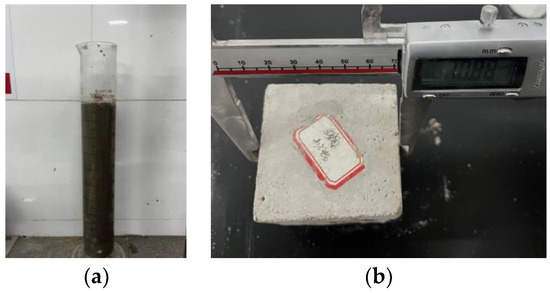
Figure 4.
Slurry stability test. (a) Bleeding test; (b) sample measurement.
According to Figure 5a, the setting time was determined based on the specification JGJ/T70-2009 “Standard Test Methods for Basic Properties of Building Mortar” using a mortar setting time tester for the test. The prepared mortar was poured into the test container, and then the penetration needle of the instrument was slowly and evenly inserted into the mortar 25 mm deep at different times, the pressure scale readings were read, and the pressure scale readings on the instrument were the penetration resistance value. When the penetration resistance value reached 0.5 MPa (15 N), this was defined as the setting time of the mortar in h. According to Figure 5b on the compressive strength test, the prepared slurry was poured into the prepared 70.7 mm × 70.7 mm × 70.7 mm cube test molds and manually vibrated to load the molds, which were placed into the constant temperature and humidity box for 7d and 28d and taken out for the compressive strength test after the specified time.
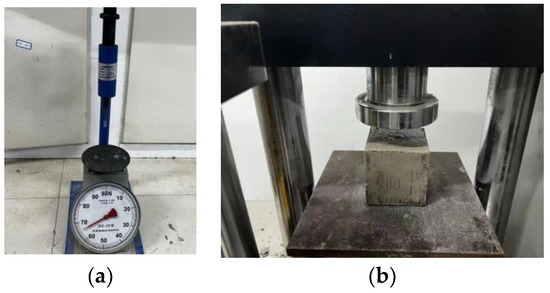

Figure 5.
Slurry strength test and water dispersion resistance test. (a) Setting time test; (b) compressive strength test; (c) pH test and consistency test; (d) water–land strength ratio test.
According to Figure 5c, for the pH value and turbidity value with reference to DLT 5117-2000 “underwater non-dispersible concrete test procedures”, we first added 800 mL of distilled water in the beaker, and then poured the prepared 500 g of mortar into the beaker ten times slowly with a hand towel. After three minutes of resting, 600 mL of water was sucked up with a glass pipette and used as a test for the pH value and turbidity value. According to Figure 5d, land and water strength ratio test involved the same ratio of cementitious materials molded in the water and air environments. When testing both the land and water strength ratios of the same age under compressive strength, we noted that the mold in the water should be completely submerged and kept at the level of the mold, the slurry should be slowly poured from the water surface height of the above into the test mold, and the preparation of the samples should be poured into the curing box after the completion of the provisions until the specified period.
SEM and XRD were employed to study the microstructure characteristics of the slurry and the chemical reactions they generated.
3. Analysis of Test Results
3.1. The Influence Factors of Shield Mud Content on Slurry Performance
3.1.1. Effect of Shield Mud Content on Slurry Fluidity
In the experiment, after the substitution of fly ash with tunneling mud in synchronous grouting, the slurry consistency was as shown in Figure 6a. From A1 to A5, as the content of shield mud replacing fly ash increased, the initial slurry consistency showed a trend of first increasing and then decreasing. At A3, the initial consistency reached a peak of 14.5 cm, which was 29.5% higher than T1. At the same time, the initial consistency value of the slurry gradually decreased at A3–A5. This was consistent with the results of Xu et al. [19] for the slurry flow properties after replacement. The main reason for this is that the particle size of fly ash is generally between 0.5 and 300 μm, which is much smaller than that of shield mud. Under equal mass conditions, the specific surface area of fly ash is larger than that of shield mud, so fly ash consumes more water than shield mud.
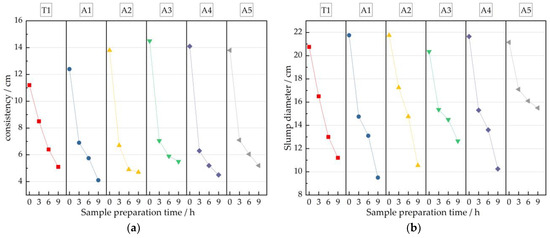
Figure 6.
The influence of different contents of shield mud on the fluidity of slurry: (a) experimental trends in slurry consistency; (b) experimental trends in slurry slump diameter.
As shown in Figure 6b, in terms of slump, the initial value of the slump of A1~A5 slurry showed a relatively stable fluctuation with the increase in the content of shield mud, which was attributed to the good cohesion of shield mud in clay stratum. Furthermore, as shown in Figure 3, after adding shield mud, the time-dependent consistency loss of the slurry at A1~A5 increased continuously with the mud content, reaching 2.6 cm/h at A4, well exceeding the specification requirements. It is also evident in Figure 4 that both A1 and A4 exhibited excessively large time-dependent slump losses. Excessive time-dependent losses severely affected the pumping distance and height of the slurry during construction, ultimately leading to pump clogging and honeycombing in cement mortar. This is in keeping with the findings of Ma et al. [29], who studied the rheological properties of cement and fly ash. The analysis attributes this to the ellipsoidal microstructure of fly ash materials in the slurry, promoting the “ball bearing effect” that aids mortar flow. However, when shield tunneling mud replaced fly ash, the irregular particle characteristics of mud and the inclusion of fine gravel in the soil increased the friction between cementitious materials and fine sand. Over time, as water continuously reacted with cementitious materials and free water was absorbed, volume expansion occurred, further increasing frictional forces. Finally, the time loss of the consistency value of the synchronous grouting slurry mixed with shield mud was too large and exceeded the specification requirements.
3.1.2. Effect of Shield Mud Content on Slurry Stability
The A1~A5 data after the replacement of shield mud can be seen in Figure 7. As the content of fly ash in the replacement of shield mud gradually increased, the bleeding rate increased, but the increase was small. The volume shrinkage rate increased first and then decreased with the increase in the shield mud content. It reached a peak of 1.98% at A3, which was not much higher than that of T1, and decreased slightly at A3~A5. This was mainly because the bentonite cementitious materials used in simultaneous grouting have strong water absorption, water retention, and stability, so the replacement of fly ash with shield tunneling mud did not significantly affect the stability of the mortar.
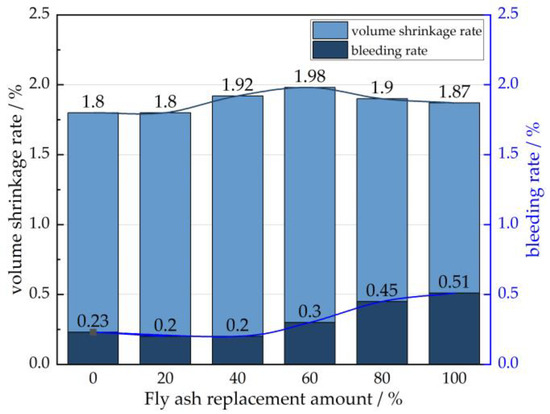
Figure 7.
The influence of different contents of shield mud on the stability of the slurry.
3.1.3. Effect of Shield Mud Content on Slurry Strength
According to specifications, the time corresponding to a penetration resistance of 15N represents the setting time of the synchronous grouting slurry. As shown in Figure 8a, after the replacement of shield tunneling mud, the setting time of the mortar gradually decreased with increasing mud replacement from A1 to A4. The shortest setting time occurred at A4, reaching 4.8 h, which was 41.6% lower than that of T1. However, at A5, the setting time increased significantly to 7.8 h, exceeding the required 4 to 6 h for on-site construction. The analysis indicates that this phenomenon was mainly due to the slower hydration reaction of fly ash compared to cement during the early hydration process of cement mortar. As a result, the early strength of cement mortar was not adequately compensated. Therefore, when shield tunneling mud was used to replace fly ash, the mortar exhibited better stability and higher strength in the early stages of setting, leading to a faster setting rate. The delayed setting observed at A5 was attributed to the increased presence of coarse particles from the shield tunneling mud in the slurry, which reduced the contact area for cement hydration reactions, ultimately resulting in a significant increase in setting time.
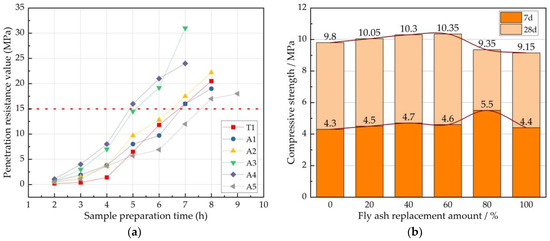
Figure 8.
The influence of different contents of shield mud on slurry strength: (a) experimental trends in the setting time of slurries; (b) experimental trends in slurry compressive strength.
In terms of compressive strength, as shown in Figure 8b, the compressive strength of A1~A5 in 7d with the increase in the amount of replacement of fly ash as a whole showed a trend of increasing and then decreasing, and the compressive strength value was the largest in A4, which reached 5.5 MPa. Compared to the T1 compressive strength, it was increased by 27.9%, and the compressive strength was decreased in A4~A5. At 28 days, the compressive strength of shield tunneling mud showed a trend of first increasing and then decreasing. The maximum compressive strength occurred at A3, reaching 10.35 MPa, but there was a decrease in compressive strength from A3 to A5. This is in agreement with the results of Xu et al. [19] and Liu et al. [22] for the strength performance curve of the slurry after replacement. The analysis indicated that early fly ash delayed the hydration rate of cement. Therefore, at 7 days, after replacing fly ash with shield tunneling mud, the overall compressive strength of the synchronous grouting slurry slightly increased. However, at 28 days, the SiO2 and Al2O3 in fly ash reacted with Ca(OH)2 generated by cement hydration to produce a significant amount of C-S-H, reducing the porosity within the slurry and increasing its density, thereby enhancing the compressive strength of the synchronous grouting slurry. Hence, after 28 days, the compressive strength from A3 to A5 slightly decreased due to insufficient fly ash content.
Combining the above experimental observations, after replacing shield tunneling mud, the synchronous grouting slurry showed good stability and strength, except that A5 had an excessively slow setting time. However, all A1 to A5 samples exhibited initial values and significant time-dependent losses in liquidity.
3.2. Improvement Scheme of Initial Value of Slurry Consistency
Due to the fact that the initial value of consistency was too large when the shield mud was used to replace the fly ash, it was necessary to adjust the water–binder ratio of the mortar to make the initial value of the consistency meet the specification requirements. The experimental analysis was carried out from two aspects of the fluidity and strength performance of the mortar. The improvement scheme is shown in Table 4.

Table 4.
Adjustment scheme of slurry water–binder ratio.
3.2.1. Liquidity Improvement Effect
Investigating the influence of adjusting the water–binder ratio of shield mud synchronous grouting slurry on fluidity, as shown in Figure 9a,b, consistency tests and slump tests were conducted on these four groups of slurries (0.52 to 0.43). As the water–binder ratio gradually decreased, both the consistency and slump diameter decreased continuously. Regarding consistency, it can be observed that the initial consistency value at a water–binder ratio of 0.46 was greater than 13 cm, while at 0.43, it was less than 10 cm.
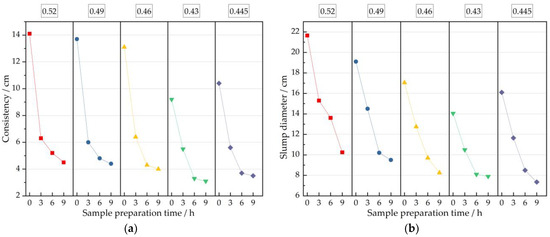
Figure 9.
The influence of water–binder ratio adjustment on slurry fluidity: (a) experimental trends in slurry consistency; (b) experimental trends in slurry slump diameter.
Regarding slump diameter, when the water–binder ratio was 0.43, the initial slump diameter was less than 16 cm. This is because reducing the water–binder ratio reduced the free water in the synchronous grouting slurry, resulting in decreased initial consistency and slump diameter values. Combining the above conclusions, neither a water–binder ratio of 0.46 nor 0.43 met the specifications. Therefore, an experiment was conducted with the intermediate value of 0.445, resulting in an initial consistency value of 10.4 cm and an initial slump diameter of 16.2 cm. Thus, a water–binder ratio of 0.445 can simultaneously meet the specifications for initial consistency and slump diameter.
3.2.2. Strength Improvement Effect
The impact of adjusting the water–binder ratio on the strength of shield tunneling mud synchronous grouting slurry was examined. In Figure 10a, it is shown that as the water–binder ratio decreased, the content of free water in the slurry also decreased, ultimately leading to a reduction in the setting time of the slurry. The shortest setting time occurred at a water–binder ratio of 0.43, less than 4 h, while the adjusted water–binder ratio of 0.445 resulted in a setting time of 4.3 h.
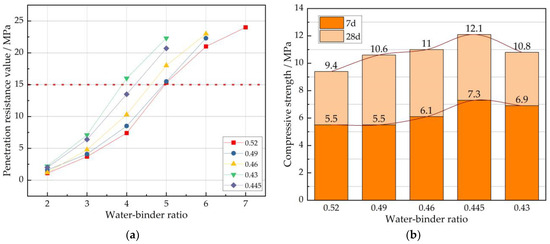
Figure 10.
The influence of water–binder ratio adjustment on slurry strength: (a) experimental trends in the setting time of slurries; (b) experimental trends in slurry compressive strength.
In terms of compressive strength, as shown in Figure 10b, the water–binder ratio between 0.52 and 0.43 exhibited a trend wherein the compressive strength at 7 days and 28 days initially increased and then decreased. At a water–binder ratio of 0.445, the compressive strength peaked at 7.3 MPa and 12.1 MPa, respectively, marking increases of 32.7% and 28.7% compared to a ratio of 0.52. However, at a ratio of 0.43, the compressive strength at 7 days and 28 days showed a slight decline due to the insufficient hydration of the slurry caused by an excessively low water–binder ratio.
Therefore, based on the results of liquidity and strength tests of the slurry, it is evident that the adjusted water–binder ratio of 0.445 exhibited a better performance in mortar properties. Hence, the slurry with a water–binder ratio of 0.445 in synchronous grouting was named T2.
3.3. Improvement Scheme of Slurry Fluidity Gradual Loss
The experiment used polycarboxylate superplasticizer as an improver for the time-dependent loss of flowability in synchronous grouting. Previous studies have shown that polycarboxylate superplasticizers effectively control early cement hydration in cement mortar, reducing the hydration reaction rate during a certain period and thus effectively improving the flow time-dependent loss rate of the slurry. Polycarboxylate superplasticizers are typically used in an amount from 0.2% to 0.4% of cementitious materials in cement mortar. Therefore, this experiment was conducted within this range, with the improvement scheme shown in Table 5.

Table 5.
Fluidity time loss improvement scheme.
3.3.1. Effect of Water-Reducing Agent on Slurry Fluidity
In Figure 11a, it can be observed that, with the increasing content of polycarboxylate superplasticizer, the initial consistency value from B1 to B4 gradually rises. At B4, it reaches 13.2 cm, which is 24.5% higher compared to T2, and exceeds the specification requirements. At the same time, the time-dependent loss of consistency from B1 to B4 is also gradually decreasing, with the time-dependent loss reducing to 1 cm/h at B3 and B4. These two experimental phenomena remain consistent with the response of polycarboxylate superplasticizer agents to the hydration process of cement slurry studied by Li et al. [30].
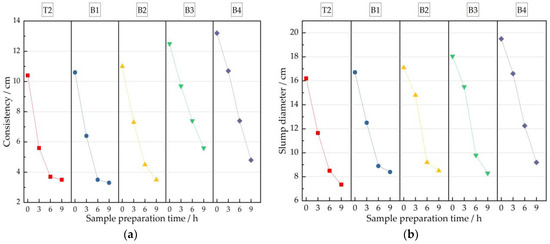
Figure 11.
The influence of different dosages of water-reducing agent on the fluidity of slurry: (a) experimental trends in slurry consistency; (b) experimental trends in slurry slump diameter.
According to Figure 11b, after adding the water reducer in the slump test, the initial diameter of the slump also showed an increasing trend, reaching 19.5 cm in B4. At the same time, the time-dependent loss of slump in each group of B1~B4 after adding the water reducer was reduced to 2 cm/h. This is in agreement with the studies on the phenomenon of retardation of cement slurry by polycarboxylate superplasticizer agents studied by Su et al. [31] and Ma et al. [32]. The main reason for this is that the mechanism of action of polycarboxylate superplasticizers is “adsorption–complexation”. During the cement hydration process, polycarboxylate superplasticizers adsorb on the surface of cement particles, thereby inhibiting the aggregation of SO42− around C3A. Additionally, some molecules of the water reducer form complexes with Ca2+, reducing the Ca2+ concentration. This prevents Ca(OH)2 from reaching its saturation rapidly, thereby inhibiting the crystallization process of Ca(OH)2.
3.3.2. Effect of Water Reducer on Slurry Stability
In Figure 12, it can be observed that the bleeding and volume shrinkage of the slurry synchronous grouting solution with added polycarboxylate-based water reducer increased with the dosage of the reducer, reaching a peak at a dosage of 0.27%. Both values remained below 3.5%, indicating a stable performance. The polycarboxylate superplasticizer exhibited good plasticity, bleeding resistance, and segregation during the experimental process.
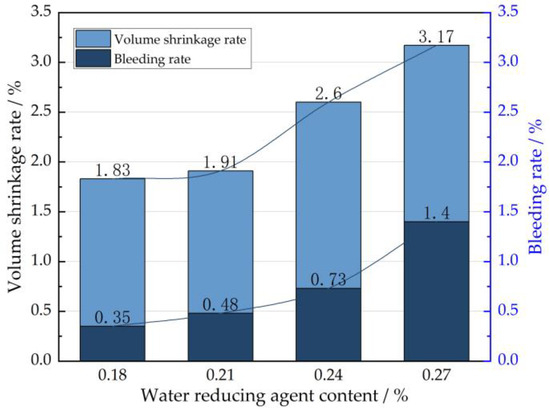
Figure 12.
The influence of different dosages of water-reducing agent on the stability of slurry.
3.3.3. Effect of Water Reducer on Slurry Strength
In Figure 13a, it can be observed that, with the increasing content of polycarboxylate superplasticizer, the coagulation time of the synchronous grouting slurry for B1~B4 gradually slowed down. The coagulation time ranged between 5 and 6 h for groups B1~B4, with B4 reaching a coagulation time of 5.8 h, which was 34.8% longer compared to T2. From the compressive strength seen in Figure 13b, it can be seen that the early strength at 7 days fluctuated overall without significant changes, but the compressive strength at 28 days showed an overall increasing trend, with B4 reaching a maximum value of 15.3 MPa.
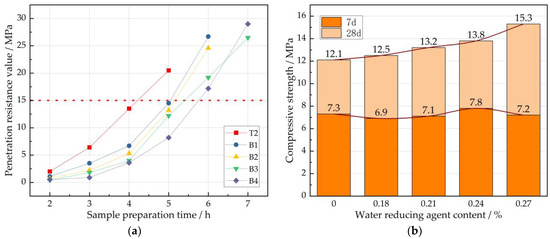
Figure 13.
I The influence of different dosages of water-reducing agent on the strength of slurry: (a) experimental trends in the setting time of slurries; (b) experimental trends in slurry compressive strength.
The results of the above two groups of trials remain consistent with the findings of the trials studied by Fang et al. [33] The analysis attributes this to the combined effect of high dispersibility of polycarboxylate superplasticizer and delayed crystallization of hydration products, resulting in more thorough hydration during the slurry coagulation curing process. This led to finer crystal sizes and more uniform and dense distribution, ultimately enhancing the overall compressive strength.
3.4. Study on Water Dispersion Resistance of Slurry
According to preliminary experiments, it was found that the slurry for synchronous grouting, after adding shield tunneling mud, exhibited poor anti-water dispersion performance, leading to severe stratification of the slurry. Simultaneously, the cement mortar’s cementitious materials continued to leach, ultimately severely affecting the slurry’s performance. Based on previous studies, experiments summarized the selection of a suitable flocculant for researching the anti-water dispersion of high-performance synchronous grouting slurry, ultimately choosing HEMC with a viscosity of 10 W [34,35,36]. According to the addition of different contents of HEMC in cement mortar, the water dispersion resistance, fluidity, and strength were studied and analyzed. Furthermore, based on previous experimental data and relevant literature abstracts [24], this study established requirements for anti-water dispersion performance: turbidity less than 100 NTU, pH less than 10, and a 28-day water-to-ground strength ratio greater than 80%. The experiments were conducted with HEMC dosages ranging from 0% to 2% of the total cementitious materials.
3.4.1. The Influence of HEMC on pH Value and Turbidity Value of Slurry
From the experimental photos in Figure 14a, it can be observed that, with increasing HEMC content, the upper-layer liquid became clearer. The data comparison in Figure 14b shows that, with the gradual increase in HEMC content, both pH and turbidity exhibited an overall decreasing trend. The change in these parameters can be divided into three segments: at 0~0.01%, the decrease in pH and turbidity was slow; at 0.01%~0.05%, there was a significant sudden change in both pH and turbidity; then, from 0.05% to 0.2%, they gradually stabilized. The above pH and turbidity test results are consistent with the findings of Ruan et al. [24].
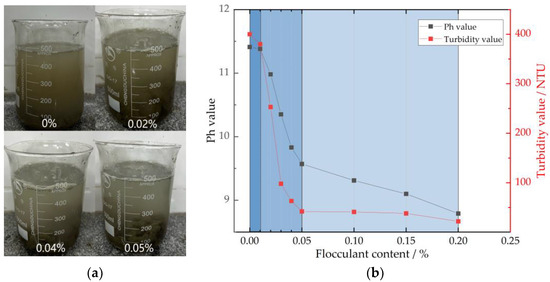
Figure 14.
The effect of different contents of HEMC on the water dispersion resistance of slurry: (a) comparison of the effects of HEMC at different contents; (b) the pH value and turbidity of HEMC slurry with different contents are affected.
Comparative analysis indicates that, when the HEMC content ranged from 0.03% to 0.2%, turbidity values were less than 100 NTU, and when the HEMC content ranged from 0.04% to 0.2%, pH values were less than 10. Therefore, when the HEMC content was 0.04%, both turbidity and pH values met the standard requirements.
3.4.2. The Influence of HEMC Content on Slurry Fluidity
In Figure 15a, it can be seen that, in terms of consistency, as the HEMC content gradually increased, the initial consistency of the slurry showed a slow declining trend, averaging a decrease of 5.1% per group. Meanwhile, the effect of HEMC content on the time-dependent consistency loss of the slurry was minimal. In Figure 15b, slump tests indicate that, with the gradual increase in HEMC, the slump diameter of the synchronous grouting slurry also gradually decreased. The initial slump diameter decreased from the initial 18.05 cm to 15.05 cm. In Figure 15b, slump tests indicate that, with the gradual increase in HEMC, the slump diameter of the synchronous grouting slurry also gradually decreased. The initial slump diameter decreased from the initial 18.05 cm to 15.05 cm. When the content reached 0.04%, the initial slump diameter reached a critical value, and the slurry exhibited good resistance to time-dependent slump loss. From the slurry consistency test, it can be seen that 0.05% was the maximum content of HEMC that the slurry could accept. Therefore, subsequent experiments will only consider the performance of HEMC content ranging from 0.01% to 0.05%.
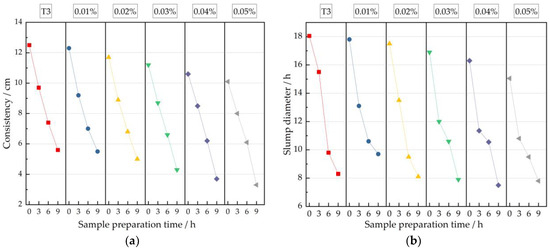
Figure 15.
The effects of different contents of HEMC on the fluidity of slurry: (a) experimental trends in slurry consistency; (b) experimental trends in slurry slump diameter.
3.4.3. Effect of HEMC on the Water-to-Ground Strength Ratio of Slurries
In Figure 16a, it can be observed that, during the 28-day curing process in a water-free environment, the compressive strength decreased significantly with increasing flocculant dosage, dropping from an initial 13.8 MPa to 7.9 MPa, with an average decrease of 10.6% per group. In contrast, the curves after 28 days of curing in water showed a lower overall strength reduction, averaging 6.2% per group. The water–land strength ratio exceeded 80% when the HEMC content was between 0.04% and 0.05%. This is consistent with the findings of the research trial by Ou et al. [37] according to which the primary reason for the decrease in compressive strength was that, during the experiment, the addition of HEMC caused the slurry to generate many small bubbles after mixing. These bubbles facilitated a “ball-bearing effect,” improving the workability of the cement mortar. However, a drawback was that these bubbles remained in the cured cement mortar, interrupting capillary action, which affected both the setting time and the compressive strength of the mortar. Ultimately, this resulted in a slight decrease in the overall volumetric density of the cement mortar blocks after 28 days of curing.
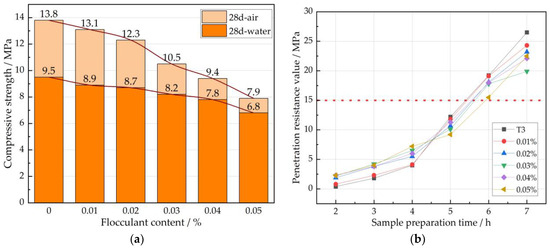
Figure 16.
The effects of different contents of HEMC on slurry strength: (a) experimental trends in the setting time of slurries; (b) experimental trends in slurry compressive strength.
As seen in Figure 16b, in the testing of the cement mortar setting time, the addition of HEMC significantly delays the setting of the slurry. With increasing HEMC content, the setting time gradually slows down, with an overall setting time ranging between 5 and 6 h [38]. The reason for this is that the addition of cellulose ether increased the consistency of the slurry, hindering the migration of free water like a cementitious material, delaying the polymerization of hydration products, resulting in a slow generation of early hydration products, and ultimately slowing down the overall setting time.
Based on the comprehensive analysis of the above indicators, it was concluded that the slurry exhibited good water dispersibility resistance when the HEMC content was between 0.04% and 0.05%. However, at 0.05% HEMC content, the initial slump diameter was too small, affecting the fluidity. Therefore, HEMC at 0.04% was chosen as the optimal dosage, designated as T4. The final proportioning scheme of the test is shown in Table 6.

Table 6.
Optimal matching scheme.
4. Microscopic Test Results and Analysis
4.1. X-ray Diffraction
From the XRD spectrum in Figure 17, it can be seen that the shield mud was mainly composed of SiO2 (quartz), CaCO3 (limestone), CaSO4-2H2O (gypsum dihydrate), and other chemicals. It was relatively more similar to a silica–aluminum type of fly ash in terms of chemical composition, and it was found that, when the shield mud was replaced by the fly ash in the synchronous grouting, the diffraction peaks of CaCO3 contained in shield mud in A4 disappeared, and the hydration products C-S-H in the synchronous grouting solution increased, which was mainly due to the hydrolysis reaction CaSiO3 + 2H2O → C-S-H of the hydrolysis product CaSiO3 after contact with water. The main reason for this is that CaCO3 underwent a hydrolysis reaction of CaSiO3 + 2H2O → CA(OH)2 + H2 + SiO2 after contact with water, and the generated Ca(OH)2 and SiO2 participated in the reaction to produce C-S-H gel, which is the most important factor for the strength formation of the grouting solution. From the above chemical reaction, it can be seen that the shield mud can be used to replace fly ash in the microscopic aspect, and at the same time give good strength performance to the slurry.
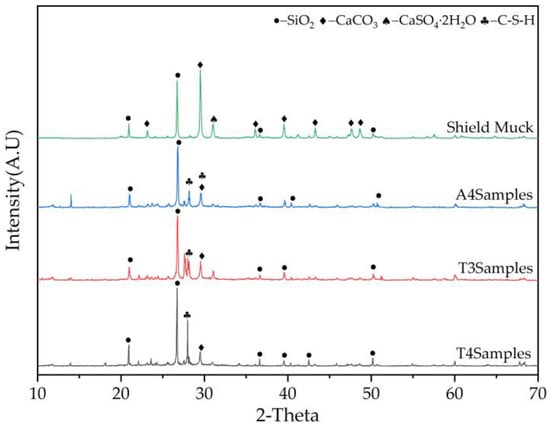
Figure 17.
XRD diffraction comparison.
4.2. Scanning Electron Microscopy
After curing for 28 days, SEM testing was performed on T1, A4, T3, and T4. In Figure 18, at a scale of 10 μm, it can be observed that, after replacing 80% of fly ash, the smooth spherical particles representing fly ash in A4, T3, and T4 significantly decreased. Partially overlapping hydration products are also visible. Additionally, in T4, partial pores can be observed, attributed to the “air entrainment” effect of HEMC. The addition of HEMC to the slurry led to the presence of numerous pores in the cementitious matrix, causing internal structural looseness and ultimately reducing the compressive strength of T4.
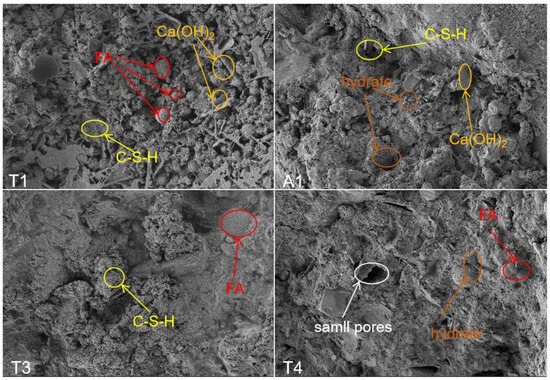
Figure 18.
SEM images of different samples at 10 μm.
At the 1 μm scale in Figure 19, abundant C-S-H cementitious products and hydrated products such as Ca(OH)2 can be observed in T1. After substitution, A4, T3, and T4 all exhibited a cross-overlapping lamellar hydration product, characterized by a unique spatial arrangement, providing robust strength support to synchronous grout slurry in the later stage of strength formation. Furthermore, the surfaces of lamellar Ca(OH)2 hydrates in A1 were relatively smooth. However, on the surface of T3 treated with polycarboxylate superplasticizer, a significant amount of C-S-H binding material adhered, indicating that the addition of polycarboxylate superplasticizer delayed hydration time, thereby enhancing hydration more thoroughly. At the 1 μm scale of T4, a significant amount of C-S-H gel was also found, indicating that hydroxyethyl methyl cellulose had little influence on the hydration reaction.
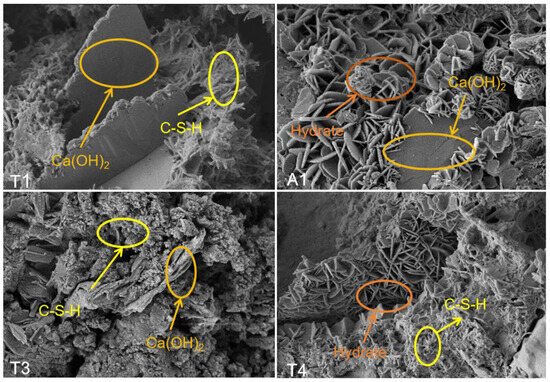
Figure 19.
SEM images of different samples at 1 μm.
5. Conclusions
Soil extraction tests were conducted on shield tunneling mud in clay formations to investigate the feasibility of replacing fly ash in simultaneous grouting with shield tunneling mud, exploring alternative solutions. The liquidity, stability, strength, and water dispersibility of the slurry were analyzed, and improvements were made to address deficiencies, including adjusting the water–cement ratio and adding cement mortar modifiers. Ultimately, the optimal mix ratio scheme was determined, leading to the following main conclusions:
- (1)
- Tests showed that, when using clay strata shield mud to replace the fly ash in synchronous grouting material, with replacement percentages of 20%~100%, the slurry achieved good compressive strength and stability, but at the same time led to slurry consistency and slump diameter of the initial value, and the time loss was too large. At a shield mud replacement of 80%, the slurry had a stronger compressive strength and a shorter coagulation time, so the use of shield mud can not only reduce project expenditure, but also greatly shorten the project duration.
- (2)
- An experiment was conducted to investigate the effects of different water–binder ratios on the consistency, slump, and compressive strength of shield mud simultaneous grouting slurries. The results indicate that adjusting the water–binder ratio significantly improved the initial consistency of the slurry. When the water–binder ratio was 0.445, the initial consistency and slump of the slurry met the specification requirements. Furthermore, it exhibited optimal compressive strength.
- (3)
- By increasing the dosage of the polycarboxylate superplasticizer agent, the fluidity and stability of the synchronized grouting slurry could be effectively improved, and its strength showed a steady growth trend. When the dosage of the polycarboxylate superplasticizer agent was 0.24%, the slurry showed optimal performance, especially regarding the flow time loss, which significantly improved. However, if the dosage of the polycarboxylate superplasticizer agent is too high, it will lead to excessive fluidity performance of the slurry, and, at the same time, there will be no phenomenon of segregation of the slurry.
- (4)
- In this study, it was found that, as the content of hydroxyethyl methyl cellulose (HEMC) in the slurry increased, the turbidity and pH of the slurry decreased and the consistency slightly reduced, while the setting time of the mortar was significantly delayed. The water dispersion resistance of the mortar was improved with 0.04% HEMC. At the same time, when the HEMC content is too high, it will seriously affect the compressive strength and fluidity of the slurry, so in the tunnel construction process, the actual water content of the geological survey environment should be used to determine the dosage of HEMC, as an excessive HEMC dosage will have a negative impact on the slurry.
- (5)
- After replacing fly ash with shield tunneling mud, XRD analysis showed a decrease in CaCO3 diffraction peaks in the shield tunneling mud, while the C-S-H diffraction peaks in the grout solution simultaneously increased, enhancing the strength formation capability. SEM analysis revealed that, in the replaced samples (A4, T3, and T4), there was a reduction in fly ash particles and the appearance of numerous interlaced hydration products, ensuring strength enhancement in the grout’s later stages. Meanwhile, the air-entraining effect of HEMC caused the loosening of the internal structure in sample T4. An analysis of the 1 μm level showed that the addition of a polyhydroxy acid water reducer delayed the hydration time and promoted the formation of C-S-H cementitious material.
Author Contributions
Conceptualization, Y.F. and Y.G.; methodology, Y.F. and Y.G.; validation, Y.F. and Y.G.; formal analysis, Y.G.; investigation, Y.G.; resources, Y.F.; data curation, Y.F. and Y.G.; writing—original draft preparation, Y.G.; writing—review and editing, Y.F. and W.T.; visualization, Y.F. and Y.G.; supervision, Y.F. and S.H.; project administration, Y.F. and Y.G.; funding acquisition, Y.F. All authors have read and agreed to the published version of the manuscript.
Funding
The authors are thankful for the financial support from the National Natural Science Foundation of China (grant number 52108315) and the National Science Foundation of Hubei Province of China (grant number 2021CFB286).
Data Availability Statement
Data are contained within the article.
Acknowledgments
We wish to thank the anonymous referees for their careful reading and for providing insightful comments to improve the initial version of this paper.
Conflicts of Interest
The authors declare no conflicts of interest.
References
- Hou, X.F.; Feng, C.H.; Yan, H.M. Overview of urban rail transit operation lines in mainland China in 2023. Urban Rapid Rail Transit 2024, 37, 10–16. [Google Scholar]
- Guo, W.S.; Wang, B.Q.; Li, Y.Z. Current status and prospects of harmless treatment and resource utilization of shield tunnel muck. Tunn. Constr. 2020, 40, 1101–1112. [Google Scholar]
- Zhu, K.F.; Zhang, Y.Y.; Xue, Z.B. Environmental issues and green treatment of shield tunnel muck. Urban Archit. 2018, 29, 032. [Google Scholar]
- Pu, C.C.; Hua, K.H.; Gao, P.H. Research progress on resource utilization of shield tunnel muck. J. Mod. Tech. Ceram. 2022, 4, 004. [Google Scholar]
- Liu, H.; Xue, D.H.; Wu, L.Y. Current situation and improvement suggestions for on-site treatment of shield tunnel muck in Shenzhen. J. Shenzhen Univ. Sci. Eng. 2022, 39, 152–158. [Google Scholar]
- Chen, R.; Yang, K.; Xiao, W. Analysis of resource utilization and treatment of engineering muck. Environ. Eng. 2020, 38, 22–26. [Google Scholar]
- Jiang, X.; Zhu, H.H.; Yan, Z.G. A state-of-art review on development and progress of backfill grouting materials for shield tunneling. Dev. Built Environ. 2023, 16, 100250. [Google Scholar] [CrossRef]
- He, S.; Lai, J.; Wang, L. A literature review on properties and applications of grouts for shield tunnel. Constr. Build. Mater. 2020, 239, 117782. [Google Scholar] [CrossRef]
- Zhou, L.; Mao, W.; Shi, M.H. Optimization Design of Synchronous Grouting Slurry Mix Ratio in Shield Tunneling. J. Wuhan Univ. Eng. 2013, 35, 29–30. [Google Scholar]
- Zhang, C.; Yang, J.; Fu, J. Recycling of Discharged Soil from EPB Shield Tunnels as a Sustainable Raw Material for Synchronous Grouting. J. Clean. Prod. 2020, 268, 121947. [Google Scholar] [CrossRef]
- Zhang, J.; Jin, J.J.; Feng, T.G. Optimization of mixture ratio of muck grout by earth pressure balance shield machine. Chin. J. Geotech. Eng. 2023, 45, 748–757. [Google Scholar]
- Cong, Z.; Kui, C.; Jun, S.Y. Reuse of Discharged Soil from Slurry Shield Tunnel Construction as Synchronous Grouting Material. J. Constr. Eng. Manag. 2022, 148, 04021193. [Google Scholar]
- Wu, T.; Gao, Y.; Huang, C. In situ resource reutilization of earth pressure balance (EPB) shield muck for the generation of novel synchronous grouting materials. Constr. Build. Mater. 2024, 421, 135737. [Google Scholar] [CrossRef]
- Ye, X.Y.; Wang, S.Y.; Yang, J.S. Soil Improvement Technology of Slurry from Muddy Sandstone Strata in Earth Pressure Balance Shield Tunneling. J. Railw. Sci. Eng. 2017, 14, 1925–1933. [Google Scholar]
- Ying, C.; Zhong, S.T. Experimental Study of High Performance Synchronous Grouting Materials Prepared with Clay. Materials 2021, 14, 1362. [Google Scholar] [CrossRef] [PubMed]
- Ni, Z.; Wang, S.; Zheng, X. Application of geopolymer in synchronous grouting for reusing of the shield muck in silty clay layer. Constr. Build. Mater. 2024, 419, 135345. [Google Scholar] [CrossRef]
- Liu, Z.X. Preparation of Unfired Bricks from Sandstone Strata Shield Tunneling Slurry and Analysis of Its Slope Protection Effect. North China Univ. Technol. 2023, 000713. [Google Scholar]
- Xi, Z.Q.; Hou, Y.K.; Li, S.S. Experimental study on the properties of non-fired bricks made from geopolymer-based fine-grained shield tunneling muck. J. Hunan Inst. Eng. 2022, 32, 83–88. [Google Scholar]
- Xu, J. Study on the reuse of shield tunneling muck incohesive soil layers for synchronous grouting. Hunan Univ. 2020, 000175. [Google Scholar]
- Lin, W.S.; Wang, H.X.; Peng, B.H. Study on the influence of shield tunneling sands from different strata on the performance of synchronous grouting materials. Tunn. Constr. 2013, 33, 715–719. [Google Scholar]
- Wang, Y.S.; Zhao, X.P.; Yuan, R. Performance and microscopic morphology analysis of shield tunnel synchronous grouting slurry prepared with weathered rock slag. J. Ho Hai Univ. 2023, 51, 65–71. [Google Scholar]
- Liu, H.G.; Ding, J.W.; Ji, F. Applicability of reusing abandoned sandy soil from shield tunnel construction at the bottom of the Yangtze River in synchronous grouting. J. Civ. Environ. Eng. 2023, 45, 134–142. [Google Scholar]
- Dai, Y.; Yang, J.S.; Zhang, C. Study on the reuse of abandoned slurry from mud-water shield tunneling in synchronous grouting materials. J. Huazhong Univ. Sci. Technol. 2019, 47, 40–45. [Google Scholar]
- Ruan, L. Study on anti-water dispersion mechanism of synchronous grouting in highly permeable and water-rich strata by shield tunneling. Southwest Jiao Tong Univ. 2019, 000109. [Google Scholar]
- Zhu, X.F.; Song, P.Y.; Du, F. Study on durability and anti-water dispersion performance of high-performance synchronous grouting materials. Concrete 2021, 12, 157–160. [Google Scholar]
- T/CECS 563-2018; Building Materials World. China Association for Engineering Construction Standardization: Beijing, China, 2022; Volume 2, pp. 7–23.
- JGJ/T 70-2009; Standard for Basic Performance Test Methods of Building Mortar. Ministry of Housing and Urban-Rural Development: Beijing, China, 2009; Volume 2, pp. 7–13.
- JC/T 2153-2012; Test Method for Bleeding of Cement. National Standardization Technical Committee Cement: Beijing, China, 2012; Volume 1, pp. 2–9.
- Ma, K.L.; Feng, J.; Long, G.C. Rheological characteristics and mechanism of cement-fly ash slurry. J. Railw. Sci. Eng. 2017, 14, 465–472. [Google Scholar]
- Li, S.; Yu, Q.J.; Wei, J.X. Influence of molecular structure of polycarboxylate superplasticizer on cement hydration process. J. Chin. Ceram. Soc. 2012, 40, 613–619. [Google Scholar]
- Su, Z.Z.; Lin, M.S.; Zhang, Z.W. Discussion on retarding mechanism of polycarboxylate superplasticizers. J. Sanming Univ. 2005, 4, 401–405. [Google Scholar]
- Ma, B.G.; Tan, H.B.; Dong, R.Z. Study on retarding mechanism of polycarboxylate superplasticizers. Yangtze River Sci. Res. Inst. 2008, 25, 93–95. [Google Scholar]
- Fang, M.M.; Xi, X.L.; Lin, D. Research status and application prospects of polycarboxylate superplasticizers. Mater. Rev. 2008, 3, 76–79. [Google Scholar]
- Saric-Coric, M.; Khayat, K.H.; Tagnit-Hamou, A. Performance characteristics of cement grouts made with various combinations of high-range water reducer and cellulose-based viscosity modifier. Cem. Concr. Res. 2003, 33, 1999–2008. [Google Scholar] [CrossRef]
- Wang, P.M.; Xu, Q.; Li, W.W. The influence of hydroxyethyl methyl cellulose on the properties of cement mortar. J. Build. Mater. 2000, 04, 305–309. [Google Scholar]
- Kovalenko, Y.; Tokarchuk, V.; Poliuha, V. The impact of methyl hydroxyethyl cellulose on cement matrix properties. East.-Eur. J. Enterp. Technol. 2020, 3, 28–33. [Google Scholar]
- Ou, Z.H.; Ma, B.G.; Jian, S.W. Influence of cellulose ether molecular parameters on the mechanical properties of cement slurry. Bull. Chin. Ceram. Soc. 2016, 35, 2371–2377. [Google Scholar]
- Zhang, G.F.; Wang, P.M. The effect of hydroxyethyl methyl cellulose on cement hydration. J. Tongji Univ. 2009, 37, 369–373. [Google Scholar]
Disclaimer/Publisher’s Note: The statements, opinions and data contained in all publications are solely those of the individual author(s) and contributor(s) and not of MDPI and/or the editor(s). MDPI and/or the editor(s) disclaim responsibility for any injury to people or property resulting from any ideas, methods, instructions or products referred to in the content. |
© 2024 by the authors. Licensee MDPI, Basel, Switzerland. This article is an open access article distributed under the terms and conditions of the Creative Commons Attribution (CC BY) license (https://creativecommons.org/licenses/by/4.0/).